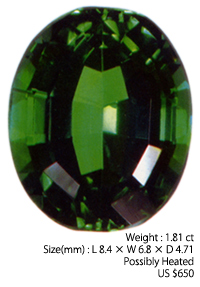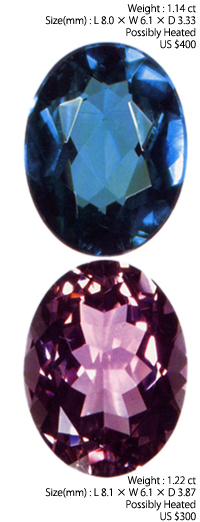VARIETIES OF COUNTRY OF ORIGIN
The main source of tourmaline is Brazil, although since the 19th century it has been found in the states of Maine and California in the United States. It is also mined in the countries of Madagascar, Mozambique, Russia, Sri Lanka, Afghanistan, and Myanmar. Most tourmaline is black, with no value as a gemstone. Here we will discuss the typical green tourmaline, blue tourmaline (indicolite), and pink tourmaline. The red and green bi-colored tourmaline is also important, but this will be considered in a future publication. |
 |
Green Tourmaline
The distinctive green of tourmaline possesses a refreshing beauty. Unlike the deep, rich hue of emerald, and different from the soft hue of peridot, its beautiful color is brought to life by superior fashioning. As can be seen from the quality scale, yellowish and brownish overtones detract from the beauty grade. |
|
Blue Tourmaline
Also called “indicolite,” this variety of tourmaline is rare. Its characteristic blue color has little or no greenish hue. However, in gem qualities the tone becomes rather dark compared to green tourmaline, causing a decrease in transparency and a distinct loss of brilliance. Despite this, the rarity of indicolite makes it more expensive than pink, green, or bi-colored tourmaline in gem qualities. |

|
Pink Tourmaline
The stone in the photograph is a non-irradiated pink tourmaline from Mozambique. It is a somewhat brownish pink, but the fact that it is not irradiation-treated is important. Unfortunately, some of the so-called “hot” pink and red tourmaline (“rubellite”) is suspected of being irradiation-treated. There is a pressing need among dealers in the trade for accurate transmission of information and an established means of detecting these irradiated stones. |
|
JUDGING QUALITY
With tourmaline it is important to first judge hue. The wide range of green hues includes a strongly yellowish green like the color of young grass, the typical pure “emerald” green, and the strongly bluish “peacock” green. The grassy green colors are not particularly popular, but pure green and bluish green are favored by many.
In general, green tourmaline is highly transparent and strongly brilliant. Stones with a beauty grade of less than B will have a decidedly brownish color. Tourmaline rough is often long and thin; those that are too long are difficult to use except in specially designed pieces, and are to be avoided. Prices, and are to be avoided. Prices are normally determined based on the shorter dimension of the rough material.
|
|